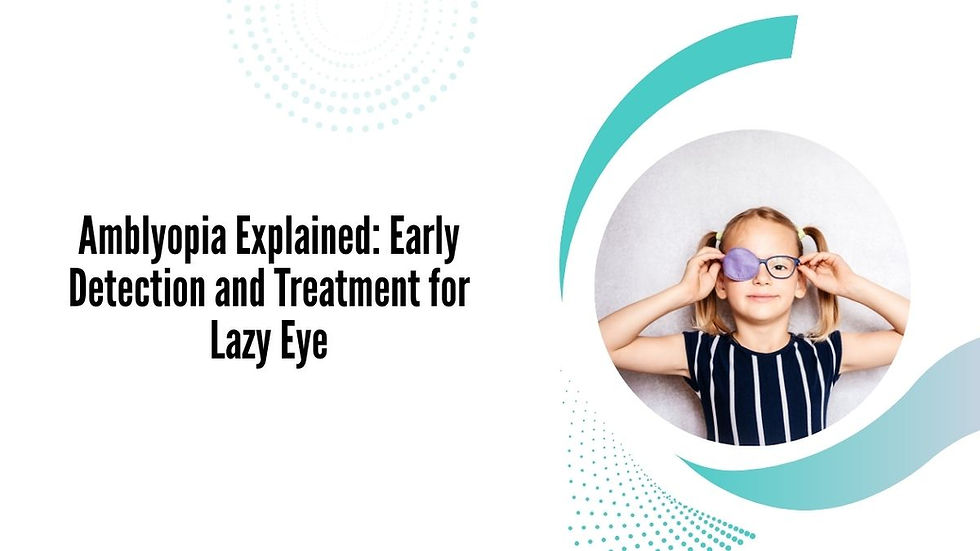Amblyopia Explained: Early Detection and Treatment for Lazy Eye
- Suryakant Jha
- Sep 8, 2025
- 4 min read
When we talk about children’s eye health, one condition that often goes unnoticed is Amblyopia, commonly known as Lazy Eye. It’s a vision development disorder where one eye doesn’t achieve normal visual acuity, even with prescription glasses. Since amblyopia usually develops in early childhood, timely detection and treatment are crucial to prevent permanent vision problems.
In this blog, we’ll break down what amblyopia is, its causes, early warning signs, and the importance of seeking timely care from the top ophthalmologist in Delhi or other trusted specialists.

What is Amblyopia (Lazy Eye)?
Amblyopia occurs when the brain favors one eye over the other. The weaker eye gradually loses its ability to work properly because the brain suppresses its signals. If left untreated during childhood, amblyopia can lead to long-term vision problems that are difficult to correct in adulthood.
The condition affects about 2–3% of children worldwide, making it one of the most common vision issues in childhood.
Causes of Amblyopia
Understanding the causes can help parents recognize the condition earlier. The main causes include:
Strabismus (Eye Misalignment): When one eye turns inward, outward, upward, or downward, the brain ignores its input.
Refractive Errors: Unequal vision in both eyes due to nearsightedness, farsightedness, or astigmatism can cause one eye to become weaker.
Deprivation Amblyopia: Conditions like cataracts or droopy eyelids that block clear vision in one eye.
Consulting the eye specialist doctor in Delhi at the right stage can ensure accurate diagnosis and effective treatment.
Signs Parents Should Watch For
Children with amblyopia may not complain about poor vision, which is why parents need to stay alert. Look out for signs such as:
Squinting or tilting the head
Frequent eye rubbing
Trouble focusing on objects
Poor depth perception
Misaligned eyes
If you notice any of these, visiting an eye doctor in South Delhi for a detailed eye exam is the best next step.
Why Early Detection Matters
Amblyopia responds best to treatment during childhood, when the brain’s visual system is still developing. After the age of 7–9 years, treatment becomes less effective. That’s why regular eye check-ups with the top ophthalmologist in Delhi are recommended for children, even if no obvious problems are visible.
Treatment Options for Amblyopia
Treatment depends on the cause and severity of the condition. Some common approaches include:
Corrective Eyeglasses or Contact Lenses
For children with refractive errors such as farsightedness, nearsightedness, or astigmatism, prescribing glasses or contact lenses is often the first step. These corrective measures allow both eyes to focus properly.
Pros: Non-invasive, easy to use, improves vision quickly in many cases.
Cons: May not be effective alone if the brain has already started ignoring the weaker eye.
Success Rate: Works well in mild to moderate cases, especially when started early.
Eye Patching
This involves covering the stronger eye with a patch, forcing the weaker eye to work harder and develop visual strength.
Pros: Highly effective in stimulating the weaker eye, improves vision significantly.
Cons: Some children resist wearing the patch; may cause frustration or self-consciousness.
Success Rate: Studies show success in 70–90% of children when started before age 7.
Atropine Drops
Instead of using a patch, atropine drops blur vision in the stronger eye, encouraging use of the weaker one.
Pros: Less noticeable than a patch, easier for children to tolerate.
Cons: Temporary side effects like light sensitivity or difficulty with near vision.
Success Rate: Comparable to patching, often recommended as an alternative.
Surgery
In cases of strabismus (misaligned eyes) or cataracts, surgery may be necessary. Surgical correction realigns the eyes or removes obstructions that block clear vision. Consulting the best eye surgeon in Delhi ensures safe and advanced treatment.
Pros: Corrects physical causes, often a permanent solution when paired with follow-up therapy.
Cons: Involves surgical risks and requires post-surgery vision therapy.
Success Rate: High success rates for restoring alignment and vision clarity, especially with early intervention.
Vision Therapy
A structured program of eye exercises and visual activities designed to train the brain and eyes to work together more effectively.
Pros: Non-invasive, improves coordination and depth perception, strengthens long-term visual skills.
Cons: Requires consistent effort and time commitment, progress can be gradual.
Success Rate: Effective when combined with glasses, patching, or surgery; particularly useful for older children and even some adults.
Choosing the Right Eye Care Specialist
Since amblyopia requires personalized treatment, finding the right expert makes a difference. Parents often prefer visiting the eye hospital in South Delhi, where advanced diagnostic tools and a team of specialists are available.
Here’s why choosing the top ophthalmologist in Delhi matters:
Accurate diagnosis using advanced equipment
Customized treatment plans for children
Regular monitoring to ensure progress
Expertise in both surgical and non-surgical treatments
Final Thoughts
Amblyopia may sound simple as “lazy eye,” but its long-term impact on vision can be serious if left untreated. Early detection and timely intervention are the keys to helping children achieve healthy eyesight.
If you suspect your child may have vision issues, don’t delay—schedule a check-up with the eye specialist doctor in Delhi or visit an eye hospital in South Delhi for comprehensive care. With guidance from the top ophthalmologist in Delhi, your child can enjoy better vision and a brighter future.










Comments